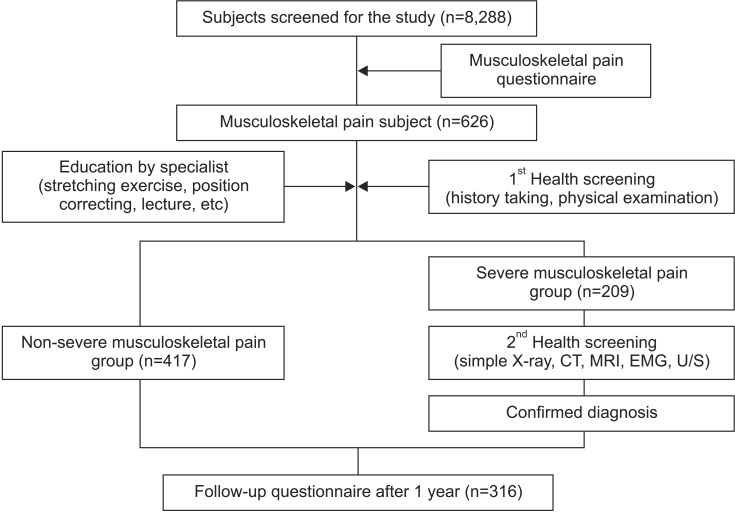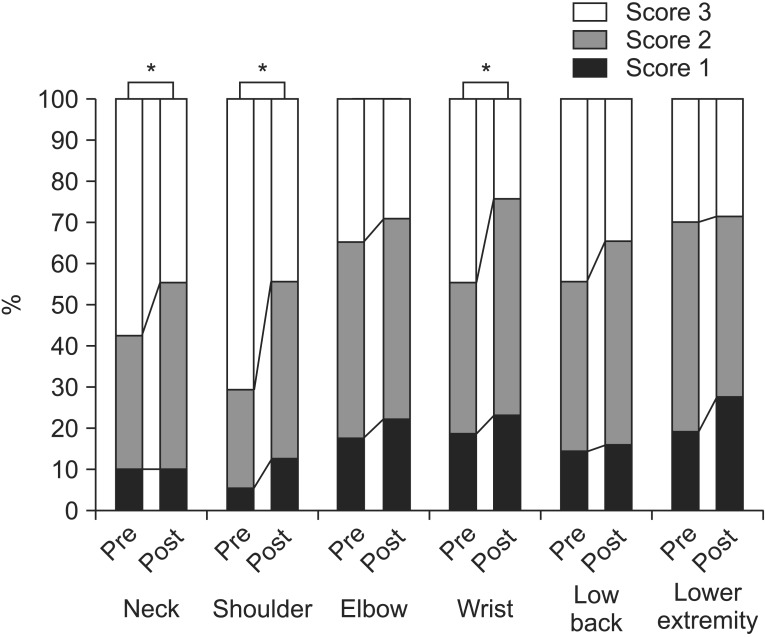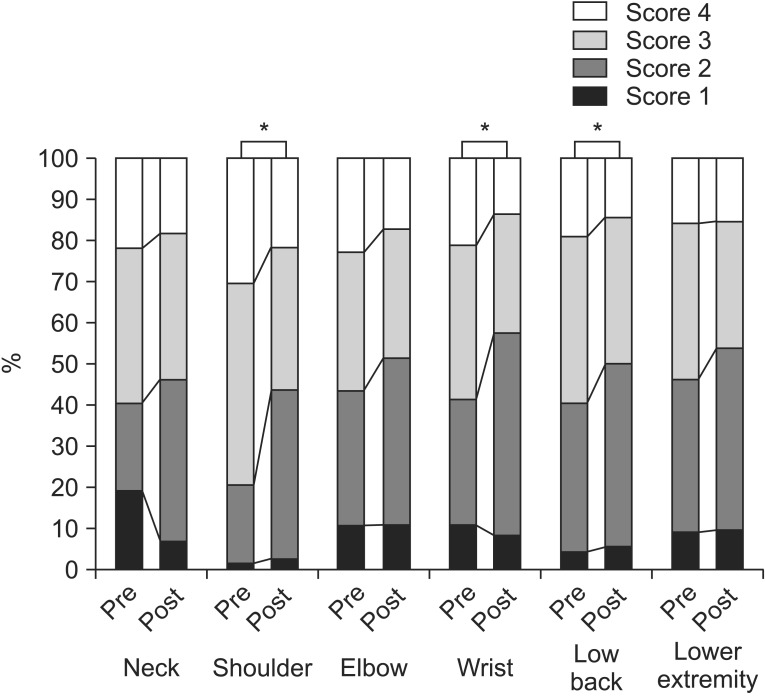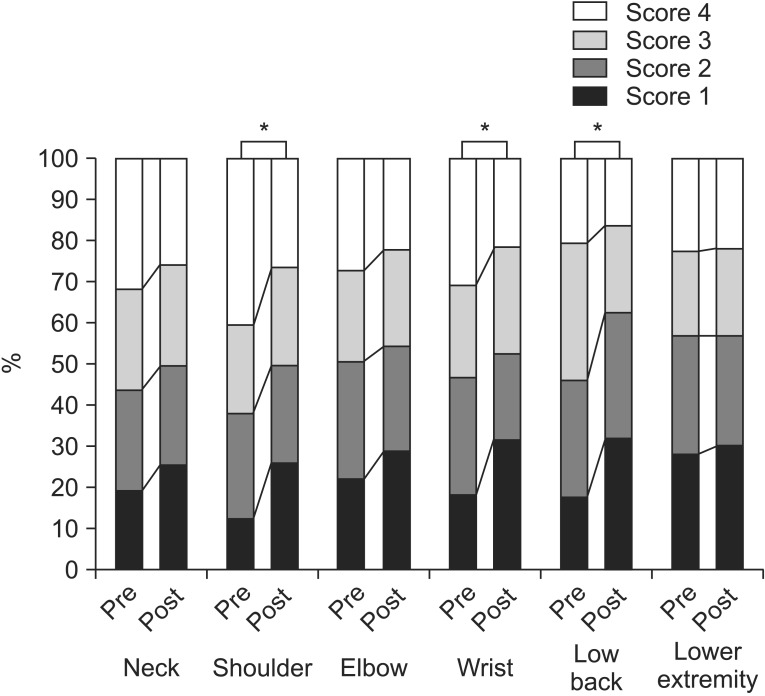Ann Rehabil Med.
2015 Oct;39(5):726-734. 10.5535/arm.2015.39.5.726.
Change in Musculoskeletal Pain in Patients With Work-Related Musculoskeletal Disorder After Tailored Rehabilitation Education: A One-Year Follow-Up Survey
- Affiliations
-
- 1Department of Rehabilitation Medicine, Hanyang University College of Medicine, Seoul, Korea. pmrdr@hotmail.com
- KMID: 2148203
- DOI: http://doi.org/10.5535/arm.2015.39.5.726
Abstract
OBJECTIVE
To apply tailored rehabilitation education to video display terminal (VDT) workers with musculoskeletal pain and to assess changes in musculoskeletal pain after rehabilitation education.
METHODS
A total of 8,828 VDT workers were screened for musculoskeletal disorders using a self-report questionnaire. Six hundred twenty-six VDT workers selected based on their questionnaires were enrolled in musculoskeletal rehabilitation education, which consisted of education on VDT syndrome and confirmed diseases, exercise therapy including self-stretching and strengthening, and posture correction. One year later, a follow-up screening survey was performed on 316 VDT workers, and the results were compared with the previous data.
RESULTS
Compared with the initial survey, pain intensity was significantly decreased in the neck area; pain duration and frequency were significantly decreased in the low back area; and pain duration, intensity, and frequency were significantly decreased in the shoulder and wrist after tailored rehabilitation education. In addition, pain duration, intensity, and frequency showed a greater significant decrease after tailored rehabilitation education in the mild pain group than in the severe pain group.
CONCLUSIONS
This study found that work-related musculoskeletal pain was reduced after tailored rehabilitation education, especially in the shoulder, wrist, and low back.
Keyword
MeSH Terms
Figure
Cited by 1 articles
-
Comparison of work-related musculoskeletal symptoms between male cameramen and male office workers
Han-Seur Jeong, Byung-Seong Suh, Soo-Geun Kim, Won-Sool Kim, Won-Cheol Lee, Kyung-Hun Son, Min-Woo Nam
Ann Occup Environ Med. 2018;30(1):. doi: 10.1186/s40557-018-0243-y.
Reference
-
1. Park KY, Bak KJ, Lee JG, Lee YS, Roh JH. Factors affecting the complaints of subjective symptoms in VDT operators. Korean J Occup Environ Med. 1997; 9:156–169.
Article2. Kwon HJ, Ha MN, Yun DR, Cho SH, Rang D, Ju YS, et al. Perceived occupational psychosocial stress and work-related musculoskeletal disorders among workers using video display terminals. Korean J Occup Environ Med. 1996; 8:570–577.
Article3. Kim HR, Won JU, Song JS, Kim CN, Kim HS, Roh J. Pain related factors in upper extremities among hospital workers using video display terminals. Korean J Occup Environ Med. 2003; 15:140–149.
Article4. Rempel DM, Krause N, Goldberg R, Benner D, Hudes M, Goldner GU. A randomized controlled trial evaluating the effects of two workstation interventions on upper body pain and incident musculoskeletal disorders among computer operators. Occup Environ Med. 2006; 63:300–306. PMID: 16621849.5. Kim DQ, Cho SH, Han TR, Kwon HJ, Ha M, Paik NJ. The effect of VDT work on work-related musculoskeletal disorder. Korean J Occup Environ Med. 1998; 10:524–533.
Article6. Shuai J, Yue P, Li L, Liu F, Wang S. Assessing the effects of an educational program for the prevention of work-related musculoskeletal disorders among school teachers. BMC Public Health. 2014; 14:1211. PMID: 25422067.
Article7. Rodrigues EV, Gomes AR, Tanhoffer AI, Leite N. Effects of exercise on pain of musculoskeletal disorders: a systematic review. Acta Ortop Bras. 2014; 22:334–338. PMID: 25538482.
Article8. Verhagen AP, Karels C, Bierma-Zeinstra SM, Burdorf L, Feleus A, Dahaghin S, et al. Ergonomic and physiotherapeutic interventions for treating work-related complaints of the arm, neck or shoulder in adults. Cochrane Database Syst Rev. 2006; (3):CD003471. PMID: 16856010.
Article9. Karjalainen K, Malmivaara A, van Tulder M, Roine R, Jauhiainen M, Hurri H, et al. Multidisciplinary biopsychosocial rehabilitation for neck and shoulder pain among working age adults. Cochrane Database Syst Rev. 2003; (2):CD002194. PMID: 12804428.
Article10. Verhagen AP, Bierma-Zeinstra SM, Burdorf A, Stynes SM, de Vet HC, Koes BW. Conservative interventions for treating work-related complaints of the arm, neck or shoulder in adults. Cochrane Database Syst Rev. 2013; 12:CD008742. PMID: 24338903.
Article11. Kim DS, Park JG, Kim GS. The guideline of survey about risk factor relating to musculoskeletal disorders. Incheon: Korea Occupational Safety and Health Agency;2008.12. Lee HK, Myong JP, Jeong EH, Jeong HS, Koo JW. Ergonomic workload evaluation and musculo-skeletal symptomatic features of street cleaners. J Ergon Soc Korea. 2007; 26:147–152.
Article13. Hwang I, Noh JI, Kim SI, Kim MG, Park SY, Kim SH, et al. Prevention of pain with the injection of microemulsion propofol: a comparison of a combination of lidocaine and ketamine with lidocaine or ketamine alone. Korean J Anesthesiol. 2010; 59:233–237. PMID: 21057611.
Article14. Baron S, Hales T, Hurrell J. Evaluation of symptom surveys for occupational musculoskeletal disorders. Am J Ind Med. 1996; 29:609–617. PMID: 8773721.
Article15. Park CY, Cho KH, Lee SH. Cervicobrachial disorders of female international telephone operators: I. subjective symptoms. Korean J Occup Environ Med. 1989; 1:141–150.
Article16. Bernard B, Sauter S, Fine L, Petersen M, Hales T. Job task and psychosocial risk factors for work-related musculoskeletal disorders among newspaper employees. Scand J Work Environ Health. 1994; 20:417–426. PMID: 7701287.
Article17. Bergqvist U, Wolgast E, Nilsson B, Voss M. The influence of VDT work on musculoskeletal disorders. Ergonomics. 1995; 38:754–762. PMID: 7729402.
Article18. de Freitas-Swerts FC, Robazzi ML. The effects of compensatory workplace exercises to reduce work-related stress and musculoskeletal pain. Rev Lat Am Enfermagem. 2014; 22:629–636. PMID: 25296147.
- Full Text Links
- Actions
-
Cited
- CITED
-
- Close
- Share
- Similar articles
-
- The Association of Workplace Psychosocial Factors and Musculoskeletal Pain Among Korean Emotional Laborers
- Work-related musculoskeletal disorders in Korean farmers
- The use of platelet-rich plasma in management of musculoskeletal pain: a narrative review
- Psychosocial Factors and Work-related Musculoskeletal Disorders among Southeastern Asian Female Workers Living in Korea
- Association of work–life balance with occupational injury and work-related musculoskeletal pain among Korean workers





